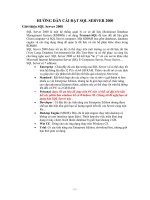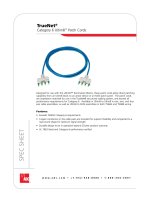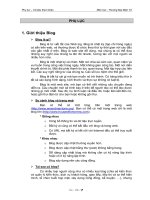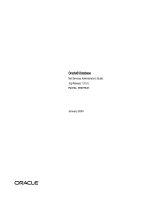Tài liệu Fravo Cisco 642-821 3.0 ppt
Bạn đang xem bản rút gọn của tài liệu. Xem và tải ngay bản đầy đủ của tài liệu tại đây (309.12 KB, 35 trang )
Fravo.com
Certification Made Easy
MCSE, CCNA, CCNP, OCP, CIW, JAVA, Sun Solaris, Checkpoint
World No1 Cert Guides
Building Cisco Remote Access
Networks (BCRAN)
Exam 642-821
Edition 3.0
© Copyrights 1998-2005 Fravo Technologies. All Rights Reserved.
642-821
1
Congratulations!!
You have purchased a Fravo Technologies. Study Guide.
This study guide is a complete collection of questions and answers that have
been developed by our professional & certified team. You must study the
contents of this guide properly in order to prepare for the actual certification test.
The average time that we would suggest you for studying this study guide is
approximately 15 to 20 hours and you will surely pass your exam. We guarantee
it!
GOOD LUCK!
DISCLAIMER
This study guide and/or material is not sponsored by, endorsed by or affiliated
with Microsoft, Cisco, Oracle, Citrix, CIW, CheckPoint, Novell, Sun/Solaris,
CWNA, LPI, ISC, etc. All trademarks are properties of their respective owners.
Guarantee
If you use this study guide correctly and still fail the exam, send a scanned copy
of your official score notice at:
We will gladly refund the cost of this study guide or give you an exchange of
study guide of your choice of the same or lesser value.
This material is protected by copyright law and international treaties.
Unauthorized reproduction or distribution of this material, or any portion thereof,
may result in severe civil and criminal penalties, and will be prosecuted to the
maximum extent possible under law.
© Copyrights 1998-2005 Fravo Technologies. All Rights Reserved.
642-821
2
Q1. When is ISDN BRI a viable option as a remote access solution?
A. A mobile user that needs access to the central site while traveling.
B. A branch office needs to connect to a mobile user.
C. A remote site with sporadic traffic needs to connect to central site.
D. A branch office requires at least 300kbps bandwidth to the central site.
Answer: C
Explanation: Basic Rate Interface (BRI) is an Integrated Systems Digital Network
(ISDN) interface, and it consists of two B channels (B1 and B2) and one D channel.
The B channels are used to transfer data, voice, and video. The D channel controls
the B channels.
ISDN uses the D channel to carry signal information. ISDN can also use the D
channel in a BRI to carry X.25 packets. The D channel has a capacity of 16 kbps, and
the X.25 over D channel can utilize up to 9.6 kbps. When this feature is configured, a
separate X.25-over-D-channel logical interface is created. You can set its parameters
without disrupting the original ISDN interface configuration. The original BRI
interface will continue to represent the D, B1, and B2 channels.
Because some end-user equipment uses static terminal endpoint identifiers (TEIs) to
access this feature, static TEIs are supported. The dialer understands the X.25-over-
D-channel calls and initiates them on a new interface.
X.25 traffic over the D channel can be used as a primary interface where low-
volume, sporadic interactive traffic is the normal mode of operation. Supported
traffic includes IPX, AppleTalk, transparent bridging, XNS, DECnet, and IP.
This feature is not available on the ISDN Primary Rate Interface (PRI).
Reference:
/>uide_chapter09186a00800d9b8a.html
Q2. Which statement is true regarding the ADSL (G.Lite G.922.2) standard?
A. Signals cannot be carried on the same wire as POTS signals.
B. It offers equal bandwidth for upstream and downstream data traffic.
C. It was developed specifically for the consumer market segment requiring higher
download speeds.
D. It has limited operating range of less than 4,500 feet.
Answer: C
Explanation: Asymmetric Digital Subscriber Line (ADSL) is designed to deliver more
bandwidth downstream (from the central office to the customer site) than upstream.
Downstream rates range from 1.5 to 9 Mbps, whereas upstream bandwidth ranges
from 16 to 640 kbps. ADSL transmissions work at distances up to 18,000 feet (5,488
meters) over a single copper twisted pair.
Reference:
642-821
3
Q3. Which command will allow a router to attempt to discover the modem to which it
is attached?
A. modem autoconfigure discovery
B. modem discovery autoconfigure
C. modem autoconfigure type discovery
D. modem discovery type autoconfigure
Answer: A
Explanation: If no modem is specified for a particular line and you have provided the
modem autoconfigure discovery command, the access server attempts to
autodiscover the type of modem to which it is attached. The access server
determines the type of modem by sending AT commands to the modem and
evaluating the response.
Reference: Building Cisco Remote Access Networks (Ciscopress) page 83
Q4. Which user requirement is best served by an access server?
A. Mobile sales force requiring dial-in access.
B. Mobile sales force requiring dedicated connection.
C. Corporate staff requiring access to web-bases applications.
D. Corporate staff requiring access to applications on corporate systems.
Answer: A
Explanation: A router act access server, which is a concentration point for dial-in and
dial-out calls. Mobile users, for example, can call into an access server at a Central
site to access their messages.
Reference: Building Cisco Remote Access Networks (Ciscopress) page 21
Q5. Which feature will cache routes learned by dynamic routing protocols, enabling
their use over DDR connections?
A. Route redistribution
B. Dynamic static routes
C. Snapshot routing
D. DDR route maps
E. Passive interfaces
Answer: A
Explanation: On the corporate side, it is very important that you be able to distribute
those addresses across the network, as desired. To redistribute those routes, you
642-821
4
need to configure the routes to be redistributed to a dynamic routing protocol at the
core side.
Reference: Building Cisco Remote Access Networks (Ciscopress) page 190
Q6. The network administrator enables Frame Relay traffic shaping and configures a
CIR of 64kbps. Using 125ms time interval, what will be the value of the committed
burst (Bc)
A. 32000 bits
B. 24000 bits
C. 16000 bits
D. 8000 bits
Answer: D
Explanation:
The calculation is TC = Bc/CIR
125ms (tc) = 8000bits (Bc)/64kbps (CIR)
Reference: Building Cisco Remote Access Networks (Ciscopress) page 352
Q7. Drag the queuing method from the list on the right to the appropriate description
on the right. (Note: not all options will be used.)
Answer:
642-821
5
Explanation:
Custom queuing – reserves a certain percentage of bandwidth for each
specified class of traffic.
Weighted fair queuing – prioritizes interactive traffics over file transfers to
ensure satisfactory response time for common user
applications.
Basic queuing – No such thing
Priority queuing – ensures the timely delivery of a specific protocol or
type of traffic because that traffic is transmitted before
all others.
Reference: Building Cisco Remote Access Networks (Ciscopress) page 399
Q9. Which of the following are examples of DTE devices? (Choose three.)
A. Mainframe computer
B. CSU/DSU
C. Router
D. Terminal
E. Modem
Answer: A, C, D
Explanation: Data terminal equipment (DTE) are end devices such as PCs,
workstations, routers, and mainframe computers.
Reference: Building Cisco Remote Access Networks (Ciscopress) page 57
Q10. Based on the configuration shown, what is the CIR of interface Serial0/0 300?
642-821
6
interface Serial0/0
no ip address
encapsulation frame-relay
no fair-queue
frame-relay traffic-shaping
bandwidth 1536
!
interface Serial0/0.100 point-to-point
ip address 10.1.1.1 255.255.255.0
frame-relay interface-dlci 100
frame-relay class cisco
!
interface Serial0/0.200 point-to-point
ip address 10.1.2.1 255.255.255.0
frame-relay interface-dlci 200
frame-relay class cisco
!
interface Serial0/0.300 point-to-point
ip address 10.1.3.1 255.255.255.0
frame-relay interface-dlci 300
!
!
map-class frame-relay cisco
frame-relay cir 128000
frame-relay adaptive-shaping becn
A. 56 kbps
B. 64 kbps
C. 128 kbps
D. 896 kbps
E. 1536 kbps
Answer: C
Explanation:
frame-relay cir
To specify the incoming or outgoing committed information rate (CIR)for a Frame
Relay virtual circuit, use the frame-relay cir map-class configuration command.
To reset the CIR to the default, use the no form of this command.
frame-relay cir {in | out} bps
no frame-relay cir {in | out} bps
Reference:
/>rence_chapter09186a0080087bcd.html#xtocid106829
Q11. Which three are responsible of IKE in the IPSec protocol? (Choose three.)
A. Negotiating protocol parameters
B. Packet encryption
642-821
7
C. Exchanging public keys
D. Integrity checking user hashes
E. Authenticating both sides of a connection
F. Implementing tunnel mode
Answer: A, C, E
Explanation: IKE is a protocol used by IPSec for completion of Phase 1. IKE
negotiates and assigns SAs for each IPSec peer, which provide a secure channel for
the negotiation of the IPSec SAs in Phase 2. IKE provides the following benefits:
• Eliminates the need to manually specify all the IPSec security parameters at
both peers
• Lets you specify a lifetime for the IKE SAs
• Allows encryption keys to change during IPSec sessions
• Allows IPSec to provide anti-replay services
• Enables CA support for a manageable, scalable IPSec implementation
• Allows dynamic authentication of peers
Reference:
/>uide_chapter09186a008017278c.html#39982
Q12. What are four PPP options that are negotiated using LCP? (Choose four.)
A. Callback
B. Multilink
C. Accounting
D. Compression
E. Authorization
F. Authentication
G. Rate adaptation
Answer: A, B, D, F
Explanation: PPP Link Control Protocol Options:
• Authentication
• Callback
• Compression
• Multilink PPP
Reference: Building Cisco Remote Access Networks (Ciscopress) page 111
Q13. Under which circumstance would use of Kerberos authentication system be
required, instead of TACACS+ or RADIUS?
A. Authentication, authorization and accounting need to use the a single database.
B. Multiple level of authorization need to be applied to various router commands.
C. DES encrypted authentication is required.
D. The usage of various router functions needs to be accounted for by user name.
642-821
8
Answer: C
Explanation: Kerberos is a client-server based secret-key network authentication
method that uses a trusted Kerberos server to verify secure access to both services
and users. In Kerberos, this trusted server is called the key distribution center
(KDC). The KDC issues tickets to validate users and services. A ticket is a temporary
set of electronic credentials that verify the identity of a client for a particular service.
These tickets have a limited life span and can be used in place of the standard user
password authentication mechanism if a service trusts the Kerberos server from
which the ticket was issued. If the standard user password method is used, Kerberos
encrypts user passwords into the tickets, ensuring that passwords are not sent on
the network in clear text. When you use Kerberos, passwords are not stored on any
machine, except for the Kerberos server, for more than a few seconds. Kerberos also
guards against intruders who might pick up the encrypted tickets from the network.
Reference:
/>094ea4.shtml
Q14. Frame Relay describes the interconnection process between which two types of
equipment?
A. DTE and DTE
B. DCE and DCE
C. CPE and DTE
D. CPE and DCE
Answer: D
Explanation: Frame relay defines the interconnection process between your customer
premises equipment (CPE- also known as data terminal equipment [DTE]) such as a
router, and the service provider’s local access-switching equipment (known as data
communications equipment [DCE]).
Reference: Building Cisco Remote Access Networks (Ciscopress) page 340
Q15. Given the following debug output, which two statements are true? (Choose
two.)
1d16h: %LINK-3-UPDPDOWN: Interface Serial3/0, changed state to up
*Mar 2 16:52:15.297: Se3/0 PPP: Treating connection as a dedicated line
*Mar 2 16:52:15.441: Se3/0 PPP: Phase is AUTHENTICATING, by this
end
*Mar 2 16:52:15.445: Se3/0 CHAP: O CHALLENGE id 7 len 29 from
“NAS1”
A. The user is authenticating with the privileged mode password “NAS1”.
642-821
9
B. This is a connection attempt to an async port.
C. The connection is established on serial interface 3/0.
D. The client is attempting to setup a Serial Line Internet Protocol connection.
E. The user is authenticating using CHAP.
Answer: C, E
Explanation: When using Chap authentication, the access server sends a challenge
message to the remote node after the ppp link is established. The remote node
responds with a value calculated by using a one-way hash function. The access
server (NAS1) checks the reponse against its own calculation of the expected hash
value.
Reference: Building Cisco Remote Access Networks (Ciscopress) page 115
Q16. Which of the following terminals can be connected to an ISDN line? (Choose
two.)
A. TO2
B. TE1
C. TE2/TA
D. NU1
Answer: B, C
Explanation:
Terminal equipment 1(TE1) - Designates a device that is compatible with the
ISDN network. A TE1 connects to a Network Termination of either Type 1 or Type 2,
such as a digital telephone, a router with ISDN interface, or digital facsimile
equipment.
Terminal equipment 2(TE2) - Designates a device that is not compatible with the
ISDN and requires a terminal adapter, such as terminals with X.21, EIA/TIA-232, or
X.25 interfaces or a router without a ISDN interface (AGS= and so on).
Terminal adapter – converts standard electrical signals into the form used by
ISDN, so that non-ISDN devices can connect to the ISDN network.
Reference: Building Cisco Remote Access Networks (Ciscopress) page 171
Q17. Serial0 on a router is configured with the command encapsulation frame-relay.
What can cause the output from the show interface command to indicate:
Serial0 is up, line protocol is down?
A. No carrier signal
B. IP subnet mismatch
C. LAPF state, down
D. LMI type mismatch
E. No IP address configured
Answer: D
642-821
10
Explanation:
"Serial0 is up, line protocol is down"
This line in the output means that the router is getting a carrier signal from the
CSU/DSU or modem. Check to make sure the Frame Relay provider has activated
their port and that your Local Management Interface (LMI) settings match.
Generally, the Frame Relay switch ignores the data terminal equipment (DTE) unless
it sees the correct LMI (use Cisco's default to "cisco" LMI). Check to make sure the
Cisco router is transmitting data. You will most likely need to check the line integrity
using loop tests at various locations beginning with the local CSU and working your
way out until you get to the provider's Frame Relay switch.
Reference:
/>14f8a7.shtml#serialupdown
Q18. Given the configuration:
access-list 101 permit ip any any
access-list 101 deny tcp any any eq ftp
dialer-list 2 protocol ip list 101
Which two statements about the configuration are true with respect to FTP traffic and
DDR? (Choose two.)
A. FTP traffic will be forwarded.
B. FTP traffic will not be forwarded.
C. FTP will cause the line to come up.
D. Since FTP uses two sockets, both must be defined to prevent packet forwarding.
Answer: B, C
Explanation:
Access-list 101 deny tcp any any eq ftp - will stop any ftp traffic to any host
dialer-list 2 protocol ip list 101 – command is used to configure dial-on-demand
calls that will initiate a connection.
Reference: Building Cisco Remote Access Networks (Ciscopress) page 187 - 194
Q19. Drag and drop the ISDN in the options column to the related term in the target
column.
642-821
11
Answer:
Explanation:
U interface – defines the two-wire interface between the NT and the ISDN
cloud.
642-821
12
TE1 – designates a device that is compatible with the ISDN
network.
R interface – defines the interface between the TA and an attached non-
ISDN device (TE2).
S/T interface – is a four-wire interface (TX and RX).
TE2 – designates a device that is not compatible with ISDN and
requires a terminal adapter.
Reference: Building Cisco Remote Access Networks (Ciscopress) page 171-173
Q20. What occurs when there is no longer a signal on the DTR?
A. The CD tells the DTE that a DCE-to-DCE connection has been established.
B. The DTE issues a RTS to the DCE enabling communication.
C. The DCE terminates its connection with the remote modem.
D. The DTE applies voltage on pin 20 to alert the DCE that it is connected and
available to receive data.
Answer: C
Explanation: Either the DTE device or the DCE device may signal for the connection
to be terminated. The signals that are used for this function are DTR from the DTE or
the modem recognizing the loss of the CD signal.
Reference: Building Cisco Remote Access Networks (Ciscopress) page 60
Q21. Which statements are true regarding the command telnet 10.10.30.4 2009?
(Choose two.)
A. It is used to reverse Telnet connection.
B. It is used to Telnet to port 2009 on a specific computer.
C. A modem is connected to line 9.
D. It specified a BRI connection to be used for Telnet.
Answer: B, C
Explanation:
B: Telnet protocol uses 2000 base TCP port for individual lines.
C: TTY lines 1 through 24 directly connect to modems 1/0 through 1/23,
which are installed in the first chassis slot in this example. The TTY lines 25
through 48 directly connect to modems 2/0 through 2/23, which are installed in
the second slot.
Reference: Building Cisco Remote Access Networks (Ciscopress) page 70
/>uide_chapter09186a00800ca657.html
642-821
13
Q22. A small remote site requires a low cost, T1 speed connection to make secure
file transfers to a central site located several hundred miles away. Which connection
type will meet the requirements of this application?
A. DSL
B. Leased line
C. ATM
D. Frame Relay
Answer: D
Explanation:
Frame Relay – Medium control, shared bandwidth, medium-cost enterprise
backbones. It uses the services of many different Physical layer facilities at speeds
that typically range from 56 Kbps up to 2 Mbps.
Reference: Building Cisco Remote Access Networks (Ciscopress) page 27 + 340
Q23. Which three of the following router IOS commands defines “interesting” traffic
for only one host using dial on command routing (DDR) (Choose three.)
A. RTA(config)#dialer-list 1 protocol ip permit 10.1.1.1
B. RTA(config)#access-list 2 permit host 192.168.1.12
C. RTA(config-if)#dialer-group 1
D. RTA(config)#dialer-group 2
E. RTA(config)#dialer-list 1 protocol ip list 2
F. RTA(config-if)#dialer-list 2 protocol ip permit
Answer: A, B, E
Explanation: Define what constitutes interesting traffic by using the dialer-list
command.
The access-list command specifies interesting traffic that initiates a DDR call.
These commands are assigned on the global configuration line.
The dialer-group command needs to be assigned to the interface responsible for
initiating the call.
Reference: Building Cisco Remote Access Networks (Ciscopress) page 188
Q24. When using PPPoE to communicate over a DSL service connection, which
process must be performed by the host to establish a PPPoE SESSION_ID?
A. A Bootp process to request a configuration and session ID.
B. A Discovery process to identify a PPPoE server and request a session ID.
C. A DHCP request process to request and IP address and session ID.
D. A RARP request process to request a MAC address and session ID.
Answer: B









